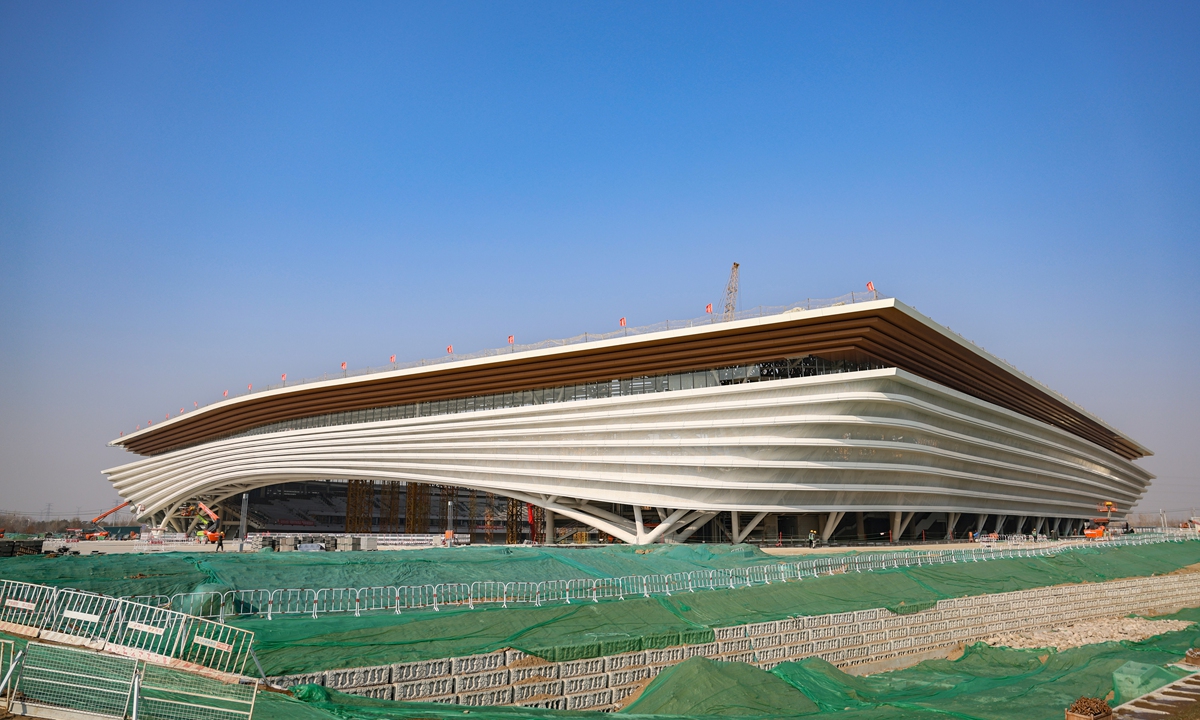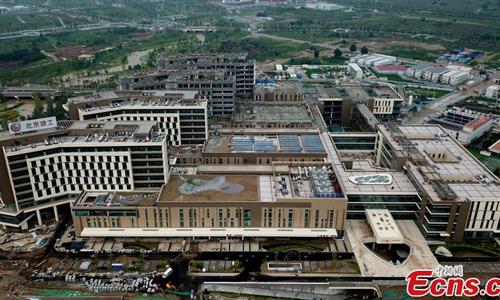Beijing-Tianjin-Hebei region drives coordinated development, advances infrastructure, economic growth

Xiong'an sports center is under construction in Xiong'an New Area, North China's Hebei Province on January 29, 2024. Photo: VCG
A decade after the proposal for coordinated development across the Beijing-Tianjin-Hebei region, the national strategy has made significant progress in various sectors, particularly in the construction of new infrastructure.
The Global Times reporter recently visited the Beijing Sub-Center railway station, which is currently under construction in Tongzhou district and is set to be the largest of its kind in Asia, as well as the Xiong'an New Area in North China's Hebei Province. These regions have witnessed the high-quality and fast-paced progress of these signature projects, which exemplify China's all-round efforts in promoting regional development and integration.
Standing at the construction site of the Beijing Sub-Center railway station in Tongzhou district on Friday, the Global Times reporter observed 89 steel pipe columns being lifted to a height of 37 meters. Approximately 90 percent of the earthwork and 85 percent of the structural work for the main body of the comprehensive transportation hub project have been completed, the Global Times learnt from local officials.
On a separate trip to Xiong'an New Area on Sunday, the Global Times gained a glimpse of the "city of the future," specifically from the construction of the area's power grid. It is so well developed that one would hardly believe everything was built from scratch just seven years ago.
The Beijing sub-center, where the Chinese capital will move many of its functions, together with Xiong'an New Area, will form two new "wings" of the city and inject more impetus to the regional development.
Solid infrastructure construction
"The Beijing Sub-Center railway station will become a new gateway to Beijing, demonstrating the vitality of the future sub-center," Meng Xiao, the project manager from the China Railway Construction Group (CRCC) told the Global Times on Friday.
Beijing is shifting some of its administrative functions out of the city center into Tongzhou, which could help address problems such as traffic congestion and air pollution. The move is also part of the Beijing-Tianjin-Hebei integrated development plan.
The Beijing sub-center is the "bridgehead" underpinning the coordinated development of the Beijing-Tianjin-Hebei region, and the Beijing Sub-Center railway station will serve not only Beijing but also the entire region, deputy general manager of Beijing infrastructure investment company Lü Gaofeng noted.
The 1.28 million-square-meter underground transportation hub is scheduled to open for commercial traffic by the end of 2024, linking cross-regional and intercity railways, as well as several metro lines. It will provide great convenience for transportation and economic exchanges and trade in Beijing, Tianjin and Hebei, after being put into use later this year, Rong Shuwei, chief engineer of CRCC, one of the project's developers, told a press conference on Friday.
The travel time from the Beijing sub-center to the Xiong'an New Area will be reduced to one hour, and it will only take 15 minutes to reach the Beijing Capital International Airport. Additionally, it will take a brief 35 minutes to reach the new Beijing Daxing International Airport after the completion of the station, according to Lü.
Xiong'an New Area, located about a two-hour drive or one-hour high-speed train ride from central Beijing and another significant regional construction project, is promoted as a high-level, ecologically friendly modern metropolis with advanced infrastructure that will emulate the city of Shenzhen and the Shanghai Pudong New Area.
The new area has completed the digitalization of all substations, which are equipped with tech-enabled environmental monitoring devices and digital inspection robotics. This allows the operators to make data-driven decisions and proactively address potential issues, as stated by Sun Guanghui, deputy general manager of the State Grid Xiong'an New Area power supply company on Sunday.
Ecological preservation is the hallmark for all aspects of local development. The 220-kilovolt Jucun electrical substation, the first load center substation in the Xiong'an New Area, has laid a solid foundation for energy transition and green development in the region, Li Jin, another deputy general manager of the State Grid Xiong'an New Area power supply company noted, adding that a carbon management information center has been built to conduct real-time monitoring of various indicators for Hebei Province.
Boosting development
According to official statistics, in 2023, the total GDP of the Beijing-Tianjin-Hebei region reached 10.4 trillion yuan ($1.46 trillion). Among this, Beijing contributed 4.38 trillion yuan, Tianjin accounted for 1.67 trillion yuan, and Hebei contributed 4.39 trillion yuan.
The development of the Beijing-Tianjin-Hebei region in the past decade has achieved notable results, not only in advancing economy but also in multiple sectors such as regional cooperation, industrial upgrading and environment protection, showcasing the strong potential and impetus for coordinated development, Wang Peng, an associate researcher at the Beijing Academy of Social Sciences, told the Global Times on Monday.
Wang also noted that the coordinated development of Beijing-Tianjin-Hebei region has elevated the competitiveness of the entire region as the cities and the province have been jointly developing and integrating each other's advantages while fostering healthy competition.
In addition to the significant progress made in infrastructure construction, the region has also expanded in multiple sectors, including tourism. Data from China Tourism Academy shows that Beijing, Tianjin and Hebei are among each other's top sources of tourists in 2023, the Xinhua News Agency reported.
Wang added that the coordinated development of the Beijing-Tianjin-Hebei region has also contributed significantly to China's overall economic growth, while helping optimize the country's economic structure with improved quality and efficiency.
While challenges such as further deepening regional cooperation and promoting industrial upgrading remain, the Beijing-Tianjin-Hebei region is able to sustain its high-quality development through integrated development, Wang said.

